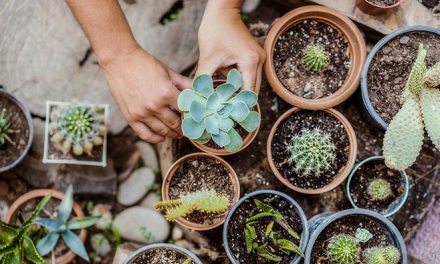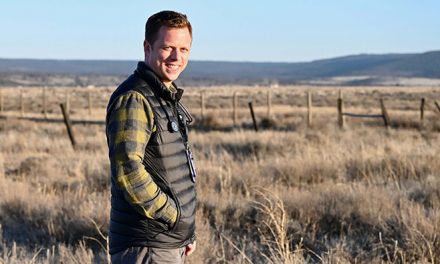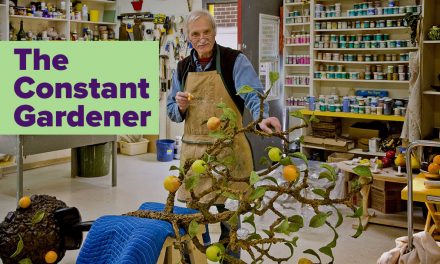The Plight of the Pollinators
UC Davis researchers are studying the bugs and birds that fertilize flowers. Many of these prized pollinators are in decline.Photography by Kathy Keatley Garvey
For more than 40 years, Arthur Shapiro, a distinguished professor of evolution and ecology at UC Davis, has counted butterflies at the same 10 spots in California. His sites span an elevation range from sea level to tree line, starting at the Suisun Marsh and crossing the Central Valley, the Sierra foothills and ending on the Eastern Sierra slope.
At each stop, he always walks the same route, jotting down every butterfly he finds. Those hikes have revealed a disturbing trend. At most of Shapiro’s sites, the number of butterflies is going down. In a 2020 paper, he and other researchers reported that butterfly abundance has been dropping by 1.6 percent annually over the past four decades across 70 locations in the western U.S.
Increasingly, researchers are finding that humanity’s footprint can crush even the small organisms we tend to take for granted, including insects. And that can be a problem for us, because humans rely on these inconspicuous fauna in many ways, including to pollinate a large portion of our fruits and veggies and nuts. UC Davis scientists are monitoring these pollinators to find out what’s behind their worrisome decline.
Pollinators and plants partner together; plants provide tasty pollen and nectar to feed on, and pollinators move from flower to flower, spreading pollen as they go and thus fertilizing the plants. Bees, butterflies, bats and other small animals not only help sustain countless wild flowering species, they also help support our food supply. Insects provide pollination services to about 75 percent of all the globe’s crops.

Monarch butterfly
Bees, birds and butterflies
Honey bees are among the most iconic pollinators, and for good reason: They fertilize $15 billion in American crops annually. In California, they visit some 25 crops, including stone fruits, melons, almonds, alfalfa and canola.
Most honey bees in the U.S. are commercially managed. Beekeepers care for this nonnative species and essentially rent them out to farms for pollinating. Almost 80 percent of U.S. honey bee colonies begin their year’s work in February in the Central Valley, where they aid farmers in pollinating almonds. Later in the year, beekeepers might truck the colonies to other crops or move them into honey production. There are also special operations just for producing honey bee queens. In fact, Northern California beekeepers raise more than a million honey bee queens a year, more than a third of the nation’s stock of queens.
But honey bees shouldn’t get all the credit. Other insects, including wild bees, not only visit farms but help support native ecosystems. More than 4,000 wild bee species and other insects protect the global food supply through pollen foraging. In California alone, there are about 500 wild bee species, said Lynn Kimsey ’76, Ph.D. ’79, a UC Davis professor of entomology and director of the Bohart Museum of Entomology. Like their more well-known cousins, wild bees have characteristic fuzzy hairs on their bodies, which snag pollen and help transport it. In contrast to the crowded colonies of honey bees, however, wild bees tend to be solitary, though some form smaller and less hierarchical societies.
Among this biodiverse bunch are bumble bees. To honor these fuzzy flying arthropods, Kimsey organizes an annual bumble bee contest; the first person to snap a photo of a bumble bee near Davis wins a coffee mug with a Franklin’s bumble bee — an extremely rare, if not extinct, species. The contest continues a tradition launched by the late Robbin Thorp, a UC Davis distinguished professor emeritus of entomology and globally regarded expert on bumble bees, who died in 2019.
Understanding the diversity of pollinators has also taken Kimsey’s career in unexpected directions. Kimsey calls herself “the queen of bug splats.” She once helped solve a murder case by examining the bugs found in the radiator grill of a suspect’s car to determine whether he had driven across the country to kill his victims.
In the mountains across the American West, climate change seems to be the biggest driver of butterfly loss.
In addition to bees, butterflies float from flower to flower to feed — though few plants are entirely dependent on butterflies, Shapiro said, adding that their most important ecosystem value is probably becoming food for birds and wasps.
Some pollinators aren’t even insects — small birds and bats visit flowering plants as well. Hummingbirds are the sole pollinator for many plants, particularly in those with trumpetlike flowers that have evolved to accommodate the tiny bird’s long beak. Lisa A. Tell ’87, D.V.M. ’91, a professor of veterinary medicine at UC Davis, has managed two hummingbird banding sites in California for more than a decade. She and her team outfit the little birds with leg bands and identification tags after taking a number of feather and body measurements. The goal is to get baseline information on the health of California hummingbirds — and see if any disease threats need attention.
One reason Tell chose to focus on hummingbirds is that they can be spotted throughout urban settings, making them a familiar wild animal. “It’s a great way to engage people, make them think about their environment and make them think about conservation,” she said about working with hummingbirds. To that end, in 2020, Tell and a UC Davis team published a children’s poetry book, If Hummingbirds Could Hum, which includes advice for how to attract hummingbirds to yards and care for an injured hummingbird.
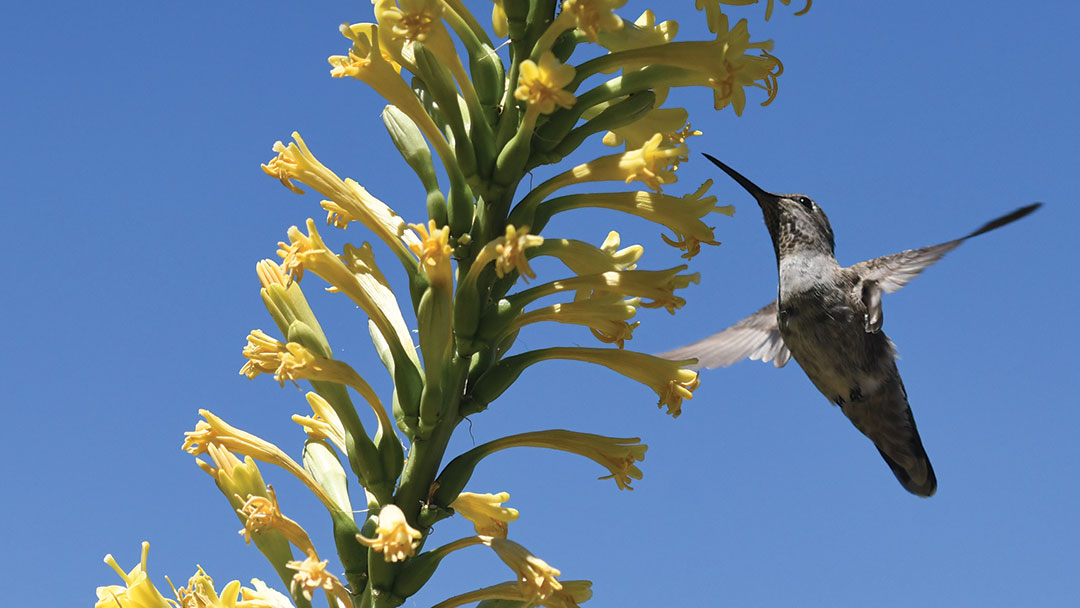
A hummingbird hovers to drink nectar from a flower.
Perils for pollinators
Research at UC Davis is revealing threats faced by these pollinators.
In his research, Shapiro has found that a number of species are in decline. Many that were once common in California’s Central Valley, including in Davis, are disappearing. The common sootywing, a small brown butterfly, is no longer common. “I only know of one breeding population in Yolo County,” Shapiro said. A similar trend is true for virtually all lower elevation species he surveys (although some high elevation sites have gained butterflies due to the insects moving to cooler zones as the climate warms). Even the charismatic monarch hasn’t been spared — its numbers have dwindled to about 1 percent of its historic population in California.
The demise of these insects is the result of many pressures caused by humans: climate change, pesticides and habitat loss. “In California, at low elevations, we find that pesticides and habitat loss are the biggest drivers,” Shapiro said. Further research is needed on pesticides, but the timing of butterfly loss is concerning: In the late 1990s, neonicotinoid pesticide use ramped up in the Central Valley; soon after, Shapiro observed that butterfly numbers in the area started to dip.
In the mountains across the American West, climate change seems to be the biggest driver of butterfly loss. In particular, warmer fall temperatures seem to be leading to butterfly decline across the region.
Similar risks may affect wild bees and other insect pollinators, too. If butterflies are dying across the West, it’s likely other insects may be vulnerable to climate change. Wild bees are also very sensitive to human disturbance because they build nests on the ground, Kimsey added. They can’t survive in our mulched and manicured landscapes. We can’t even count the losses to wild bees because many species remain unnamed by entomologists, Kimsey said. In other words, some pollinators may be quietly fading from existence before we’ve ever met them.
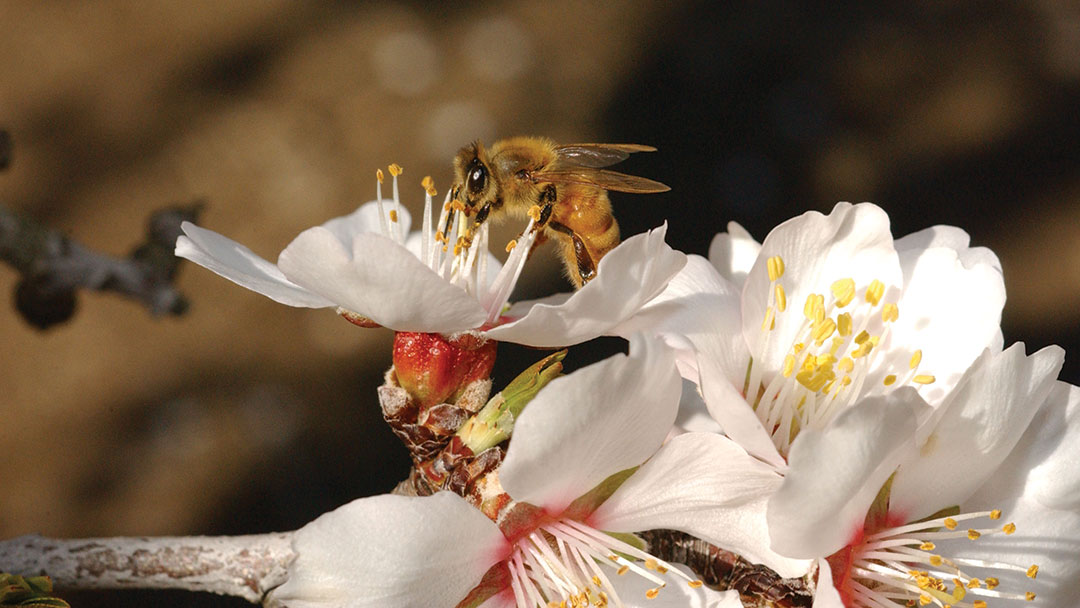
A honey bee gathers pollen from an almond blossom.
Though honey bee survival can vary a lot from year to year, the U.S. Department of Agriculture reports that colony loss has accelerated since the early 2000s; historically, about 15 percent of colonies were lost every year. In recent years, the annual colony loss has been between 30 and 45 percent. For honey bees, their threats fall under the four Ps: pests, pathogens, pesticides and poor nutrition, explained Elina L. Niño, an apiculture extension specialist at UC Davis. Varroa mites can devastate honey bee colonies, as can an outbreak of disease. And, just like people, honey bees need variety in their diet to sustain them; they can’t get all the nutrients they need if there’s only one food source around for miles.
Even fungicides can be a problem. When bees fly between flowers, they don’t just pick up pollen and nectar; some yeast also clings to their legs. The yeast ferments the pollen and nectar, producing a special “bee bread” that contains nutrients that developing bees need. So if that yeast is killed off in a fungicide application, honey bee health can suffer.
Tell hasn’t found a downward trend in her hummingbird monitoring, but noted a few concerns. She’s measured neonicotinoid pesticides in samples from hummingbirds at concentrations that might be enough to affect their health over the longer term, though more research is needed to understand this exposure. Hummingbirds are also at risk from more acute threats, such as colliding with windows and falling victim to pet cats.
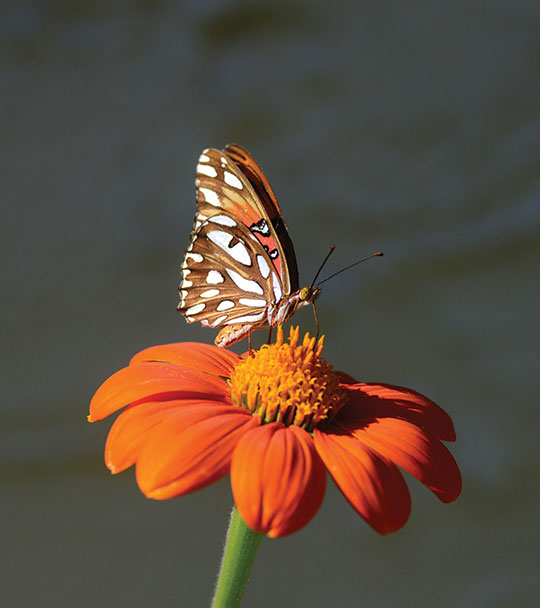
A gulf fritillary rests on a tithonia flower.
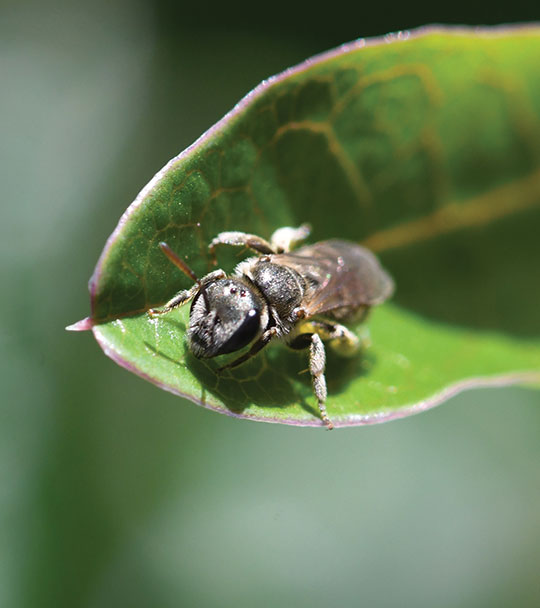
A bee native to California.
How to protect pollinators
The good news is we can have our almonds, peaches and tomatoes and protect bees, too. Simply expanding the menu for honey bees can go a long way. In her research, Niño tracked the effect of putting mustard plants within almond orchards. When bees have access to this “supplemental forage,” more of them survive through the year. Niño found that having this boost to nutrition enables bees to live longer and lessens the likelihood of colony loss.
For wild pollinators, incorporating rows of forage vegetation in between fields of crops can help sustain them. Even weedy plants that grow in drainage ditches can be sources of food for butterflies, Shapiro said. Just a slice of land left alone for wild insects can go a long way in preventing their decline. (That, and, of course, tackling the global climate crisis.)
Even if you’re not a farmer, you can still help pollinators. After hearing about honey bee die-offs, people often want to try their hand at beekeeping. If that’s you, Niño advised that you take on the project armed with science-based practices. Poor management can lead to disease in colonies, and illnesses can sometimes spread outside the colony. Niño leads the California Master Beekeeper Program, which offers classes from the basics of backyard beekeeping to running commercial operations.
The easier option to help bees and butterflies, however, is to plant more pollinator-friendly vegetation in your yard. The website for the UC Davis Bee Haven offers suggestions for what to plant, and Art Shapiro’s Butterfly Site has tips on how to attract butterflies. “I like to tell people that we actually live in this sea of moving butterflies, they’re around us all the time moving through urban and suburban habitats, looking for resources,” Shapiro said. “If you plant the right resources, you’ll increase their likelihood of surviving.”
You can also choose native plants that provide food for hummingbirds. While hummingbird feeders can be helpful, too, they must be cleaned regularly — in hot summer weather, that’s every day — in order to prevent the sugar water from fermenting or growing harmful microbes, Tell said.
Even nonnative plants can help feed butterflies, Shapiro said. “There’s a myth that only native plants are useful.” Amid the backdrop of an overall decline, some of our landscaping choices have even sustained new species. The gulf fritillary — a large, bright orange butterfly — is native to the southern U.S. and Central and South America. But thanks to the popularity of passionflower, its host plant, in gardens, the fritillary has spread widely across the northern Central Valley in the past 15 years. “At a time when we’re losing butterfly species, it’s nice to have gained one,” Shapiro said.

